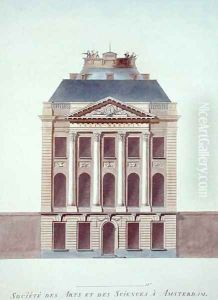Jacob Otten Husly Paintings
Jacob Otten Husly was a Dutch architect and artist, recognized for his contributions to Dutch classicism in the 18th century. Born on August 16, 1738, in Huis ter Heide, a village in the Dutch province of Friesland, Husly was the son of a wood-carver, which likely influenced his early exposure to artistic craftsmanship.
Husly's talent became evident at a young age, and he received his initial training in architecture and art from local masters in the Netherlands. He further developed his skills by studying the works of classical and contemporary European architects. Husly was particularly influenced by the neoclassical movement, which sought to revive and emulate the principles and style of ancient Greek and Roman architecture.
Throughout his career, Husly made significant contributions to Dutch architecture. He was appointed city architect of Amsterdam, where he was involved in the design and construction of various important structures. One of his most notable works is the design of the Felix Meritis building in Amsterdam, which was completed in 1788 and is considered an exemplar of Dutch neoclassicism. The building served as a center for science and culture and symbolized the Enlightenment ideals that were prevalent at the time.
In addition to his architectural endeavors, Husly was also an active member of several cultural and artistic societies. He played a role in the establishment of the Royal Academy of Fine Arts in Amsterdam, which aimed to promote the arts and provide education to young artists. Husly served as the academy's first director, demonstrating his commitment to the advancement of the arts in Dutch society.
Jacob Otten Husly died on July 14, 1796, in Amsterdam. His legacy is carried on through his architectural works and his influence on Dutch neoclassicism. Today, his contributions are studied by art historians and are recognized as an integral part of the architectural heritage of the Netherlands.
